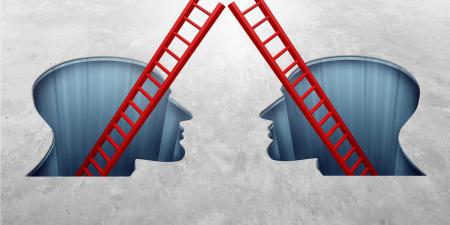Case
Mr. Adams arrived at the hospital by ambulance after the sudden onset of right-sided weakness and difficulty finding words while he was at his construction work site.
By the time Mr. Adams reached the emergency room his deficits had mostly resolved. His medical history was notable for irregular care. He had been told some years earlier that he had diabetes and high cholesterol. He had smoked a pack of cigarettes a day for over 30 years. His physical exam noted BP 190/120 and mild weakness in his right arm. Cranial nerve and mental status exams were normal, and his blood glucose was 202 mg/dl. A head CT showed no acute lesions. Mr. Adams was diagnosed with a transient ischemic attack (TIA) and admitted to the neurology service for overnight observation.
The next day, Dr. Howard, the attending neurologist, came by to have a discussion with Mr. Adams about his care going forward.
“You were very lucky,” said Dr. Howard, “that this mini-stroke seems not to have done any permanent damage. Next time you might not be so lucky, so we need to do some work to prevent you from having a full-blown stroke. You’ve got several stroke risk factors that we’ll want to do something about.”
“Like what?” asked Mr. Adams.
“Well for one thing you’ve got diabetes, so we’ll need to work on getting your blood sugar under control,” said Dr. Howard. “You’ve also got high blood pressure and high cholesterol, both of which put you at further risk for stroke. Plus, smoking puts you at increased risk, so you’ll need to work on quitting.”
“I don’t know about all that,” Mr. Adams responded, somewhat defiantly.
“Well, to reduce your risk of having another stroke you’ll need to change your lifestyle some,” said Dr. Howard. “That’ll mean pills to control the diabetes, cholesterol, and blood pressure, but it’ll also mean eating right, exercising, and quitting smoking as soon as you can.”
“That sounds like a lot,” said Mr. Adams.
“It’s your life we’re talking about,” said Dr. Howard.
“Yeah, well, I handled this stroke OK, and you know, when the Lord wants to take me, He’ll take me whatever I do,” said Mr. Adams. “I don’t see the need to bother with a bunch of new pills.”
Dr. Howard was somewhat taken aback by this line of reasoning. He was adamantly agnostic and thought of belief in a higher power as a coping mechanism. Nevertheless, he responded, “Look, God is in control, but that doesn’t mean we don’t have to take some responsibility for our lives. He gave us free will and allowed us to choose what to do. And now you’ve got a choice whether to save your life, and you can’t just palm that off on God.”
“Well, I guess not,” said Mr. Adams.
“Good,” said Dr. Howard. “I’ll have one of our stroke educators come talk to you more about this, and we’ll get you set up with a doctor to have your diabetes, cholesterol, and blood pressure followed.”
Commentary
The role of religion in health care continues to be a point of contention, while concurrently offering creative possibilities if properly understood and thoughtfully appropriated [1]. This case provides a context for considering at least three core issues relevant to this conversation: (1) the relationship between religion and health, (2) ethical implications for the physician in the practice of medicine, and (3) the role of the chaplain in health care. Each of these merits its own essay, but we will focus our discussion by addressing each one through the particular lens of this case.
The one clear consistent association between religion and health documented in the literature is the association between attendance at religious services and health [2]. Although this finding is consistently present even when controlling for multiple potential confounders such as physical functioning and mobility, it should be noted that this is an association without any presumption or claim to causality. In spite of the lack of scientific evidence of causality between religion and health relevant to clinical practice, statements such as Mr. Adams’ comment attributing his destiny to God are common in medical practice and merit clinical consideration. Cultural sensitivity to the worldview represented by Mr. Adams is a crucial part of establishing a working patient-physician relationship, and consideration of diverse examples of worldviews is an important dimension of clinical competency in medicine.
The breadth of traditions and cultural perspectives represented within the typical pluralistic health care setting frequently challenges us and may well evoke spontaneous responses of incredulity or amazement, but a more considered response is called for if we are to practice responsibly. Dr. Howard is described as having been “taken aback” by Mr. Adams’ response to his illness and particular worldview. One of the challenges for medical education currently is to adequately equip physicians to interpret and understand the breadth of culturally contingent perceptions of illness and therapeutics, so they can engage patients genuinely and constructively without interjecting a prejudiced view of the patient and while maintaining cultural, philosophical, and religious integrity for the practicing physicians themselves.
Sustaining the ethical integrity of the practicing clinician, while honoring the patient’s worldview, is an integral part of the engagement of this issue [3]. While the outcome appears constructive when Dr. Howard uses “God language” to convince Mr. Adams of the importance of lifestyle changes and medication compliance to address his medical problems, we can legitimately ask whether Dr. Howard can make the statement, “God is in control,” credibly and with authenticity in light of his self-avowed personal agnosticism. Using the patient’s language and worldview constructs to challenge the stated position of the patient and establish a treatment plan—implying these are shared by the physician when they are not—could be interpreted as manipulative and deceptive. Within our accepted views of providing good health care, the health behaviors and medical adherence advocated by Dr. Howard seem laudable at first glance, but we need to consider whether the process by which he got to this outcome was the most ethical or responsible for either Dr. Howard or Mr. Adams.
Can patients legitimately expect honesty from their physicians regarding their own views and beliefs on such matters, especially when the explicit or implied perspective is being used for establishing a therapeutic alliance or fostering compliance with a treatment regimen? Do physicians owe it to themselves to maintain their own integrity concerning their religious and philosophical worldviews when theirs differ from those of their patients? If we are attentive to the power differential inherent to the patient-physician relationship and to the inevitability of differences between the patient and physician with regard to religious and philosophical worldviews in increasingly pluralistic health care settings, the answer to these questions should be a resounding yes. If medical students and physicians are given opportunities to examine their own religious views thoughtfully—while learning about other traditions with attentiveness to implications for the clinical setting—they are less likely to be “taken aback” when confronted with perspectives radically different from their own.
While substantial progress has been made in incorporating spirituality into the curriculum in a growing number of medical schools, the quality and depth of that instruction is quite varied. It can be argued that adequate education of medical students and physicians regarding the religious and cultural traditions represented by their patients is not feasible within the limited time and resources of medical education. This may be true, yet, if physicians are to understand patients informed by varied and distinctive worldviews, they must at least commit time to examine themselves and gain a level of comfort with the diversity of possible religious and philosophical lenses through which their patients may interpret and respond to illness and suffering. The ethical and optimally competent practice of medicine is dependent on an intentional approach to this self-understanding.
The goal is to develop an ability to understand better how one’s patient engages illness and interprets therapeutic interventions, without prejudice and with an appreciation for the particular cultural and religious perspective brought to the clinical encounter by the patient. This “appreciation” does not imply agreement and should not be seen as necessitating that the physician enter into a worldview or use of religious or cultural language other than his or her own. Efforts to do so lack authenticity and imply a potential manipulative coercion that compromises both the integrity of the clinician and respect for the legitimacy of the patient’s own worldview.
An important alternative for the physician or other health care professional is consultation with a chaplain colleague. Although all clinical settings do not have chaplains, most hospitals, especially teaching hospitals, have chaplains on staff or available within the community. While it is unrealistic to expect availability of chaplains from all the major religious traditions in all hospitals at all times, chaplains who have completed clinical pastoral education (CPE) training and are members of national chaplaincy associations can be expected to have a breadth of background to provide collegial and informed assistance in dealing with clinically relevant religious issues with most patients. Although chaplains are frequently consulted when approaching end-of-life issues with patients and their families, their potential for service is much broader. Most chaplains would be pleased to advise on more nuanced spiritual and religious dimensions of daily patient care than is typically done.
Good clinical care includes sensitivity and curiosity about the cultural and religious values and beliefs of our patients. We will most likely give proper attentiveness to these issues if we have given some intentional consideration to our own perspectives and have been provided with basic education regarding the impact of cultural and religious worldviews on the interpretation of suffering and response to illness. Opportunities for thoughtful self-examination and clinical strategies for honoring and responding to the worldviews our patients bring to the clinical setting should be part of primary medical education and a component of the continuing medical education of physicians. Authentically engaging patients with a genuine curiosity regarding religion and spirituality in their understandings of health and illness adds a depth and richness, the lack of which we frequently bemoan in the current practice of medicine. Intellectually educating and practically equipping medical students and physicians for this engagement is vital to assure ethical and clinically competent care of our patients, while preserving the personal integrity and sense of authenticity for those providing care.
References
-
Shuman JJ, Meador KG. Heal Thyself: Spirituality, Medicine, and theDistortion of Christianity. New York, NY: Oxford University Press; 2003.
-
Koenig HG, McCullough ME, Larson DB. Handbook of Religion and Health. New York, NY: Oxford University Press; 2001.
- Curlin FA, Lawrence RE, Chin MH, Lantos JD. Religion, conscience, and controversial clinical practices. N Engl J Med. 2007;356(6):593-600.



